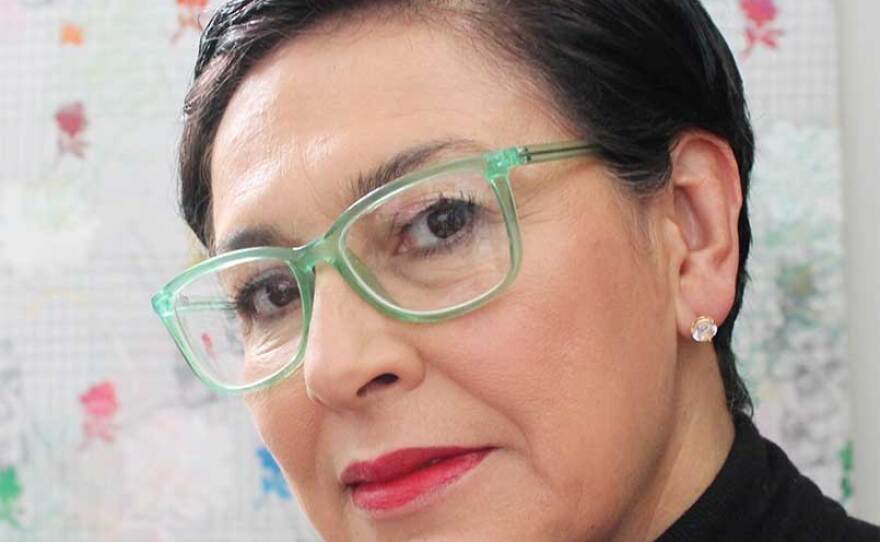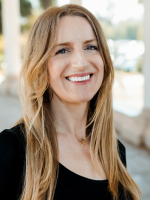San Diego artist Claudia Cano's performance-based art and photography features many characters and identities, but the most well-known is her Rosa Hernandez character, a Latina cleaning worker dressed in a pink and white uniform.
First performed in an exhibition at the Torrance Art Museum in Los Angeles, the installation includes a photograph of Cano as Rosa at work, but also the physical objects of her broom and dust pan. But Cano, who was raised in Toluca, Mexico, brings Rosa to life. At the exhibition's opening reception, the museum removed the work of photography, and Cano, dressed and fully in character as Rosa, swept and mopped the floor while reception attendees mingled around her.
Cano, and the work "Rosa Hernandez — the Cleaning Lady, 2012-16," is part of a new exhibition at the Museum of Contemporary Art San Diego (MCASD), "To Tame A Wild Tongue: Art After Chicanismo."
The exhibition explores themes of Chicanx, Latinx and border art, and is part of the build up to the delayed "Yolanda López: Portrait of the Artist" exhibition — the first solo exhibition of López's work in a museum.
The virtual exhibition for "To Tame A Wild Tongue" includes a series of monthly "charlas" or talks, to be broadcast on Instagram Live as conversations between curator Alanna Hernandez and artists. Cano will discuss her performance art, as well as what new meaning this current moment brings to her work.

RELATED: Only Here Podcast: The Cleaning Lady Wants You To Know Her Name
The Latinx worker, Cano said, is invisible. But sometimes, she said, Rosa can become a spectacle — particularly when she is among people who are expecting a show, such as exhibition attendees. But the COVID pandemic has cast a harsh light on the role of the worker in a reopened economy.
"It accentuates the reality of Latinx workers, how it has always been," said Cano. "Now we're dealing with life and death. I can't believe people are sitting in restaurants, waiting to be served."
Cano said that frontline workers in restaurants and other reopened businesses are predominantly Latinx, working while wearing plastic face shields for their safety.
"Who can be comfortable being served?" Cano asked.

Inequality in communities of color, said Cano, is not new to or induced by the pandemic, but it has been unavoidably brought to the forefront.
"It's the opportunity to have a conversation about who is Rosa, why Rosa, why Rosa is so important nowadays during COVID. There are so many women who have to leave their families to go to work," Cano said. She pointed out the percentage of Latinx affected by COVID — recent analysis of county-wide data shows that although Latinos make up 34% of the population, they account for 61% of infections and 45% of the deaths. "I wonder how many of them are Rosas or cleaning ladies. It's an opportunity to talk about it," Cano said.
RELATED: San Diego’s Black And Latino Neighborhoods Hit With COVID-19 Triple Whammy
Cano said that this is a time to be aware, and conversations are happening. "I have never had conversations about inequality the way that I'm having with my friends, with my white friends," she said. "It is now on the table. Even at my job."
The online exhibition, "To Tame A Wild Tongue," features the work of more than 25 artists, ranging from the 1980s to the present. The title is a nod to Gloria Anzaldúa's essay, "How to Tame a Wild Tongue," which highlights the role of language in borderlands. The exhibition takes these ideas into a post-Chicano movement space using works from MCASD's permanent collection.
A total of five "charla" artist talks are included in the project, and the second, featuring Cano, takes place Thursday at 11 a.m. and will be available for viewing afterwards on IGTV and YouTube. The July talk with Amy Sánchez Arteaga and Misael Díaz is also archived.
Future charlas include Julio César Morales, Perry Vasquez and David Avalos. Digital programming for the Yolanda López exhibition begins this fall, with an in-person exhibition slated for 2022.







